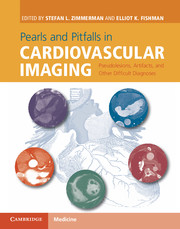 Pearls and Pitfalls in Cardiovascular Imaging
Pearls and Pitfalls in Cardiovascular Imaging from Section 2 - Cardiac aneurysms and diverticula
Published online by Cambridge University Press: 05 June 2015
Imaging description
Ventricular diverticula and clefts are rare congenital outpouchings of the ventricular cavity. No generally accepted formal definition of these entities exists, which has resulted in inconsistency in the nomenclature used in the literature. Recently, some authors have attempted to more precisely define these lesions, making a distinction between ventricular diverticula, clefts, and congenital aneurysms; whereas prior reports have used the term diverticulum more broadly to include any type of congenital outpouching of the ventricular cavity. Per the definitions suggested by Erol et al., diverticula are narrow-necked saccular outpouchings that extend beyond the confines of the myocardium, contain all three myocardial layers, and contract with the ventricle (Figures 15.1,15.2). Clefts are narrow fissure-like outpouchings of the ventricular cavity that do not extend beyond the margins of the myocardium and are obliterated during systolic contraction (Figure 15.3). These are most often located in the left ventricular side of the septum or inferior wall. Clefts are a confusing entity as several terms have been used to describe lesions of a similar description and imaging appearance within the literature, including diverticula, clefts, and crypts. Finally, congenital aneurysms are defined as wide-mouthed, thin-walled outpouchings beyond the myocardial contour that show dyskinetic motion with ventricular contraction and contain fibrous tissue. On cardiac MRI, clefts and diverticula will show contraction during systole on cine images and late gadolinium enhancement (LGE) is absent. Descriptions of cardiac MRI findings of congenital aneurysms are lacking, but presumably these lesions would show dyskinesia on cine images and LGE due to fibrous content.
Importance
Ventricular diverticula and clefts are important to distinguish from acquired ventricular aneurysms, particularly false aneurysms which carry a risk of rupture and require prompt attention. Outcomes were favorable in one series that followed children with left ventricular diverticula, unlike those with congenital aneurysms. Ventricular clefts are considered to have no adverse prognostic significance.
Typical clinical scenario
Ventricular diverticula are very rare and most often associated with congenital heart disease.
To save this book to your Kindle, first ensure [email protected] is added to your Approved Personal Document E-mail List under your Personal Document Settings on the Manage Your Content and Devices page of your Amazon account. Then enter the ‘name’ part of your Kindle email address below. Find out more about saving to your Kindle.
Note you can select to save to either the @free.kindle.com or @kindle.com variations. ‘@free.kindle.com’ emails are free but can only be saved to your device when it is connected to wi-fi. ‘@kindle.com’ emails can be delivered even when you are not connected to wi-fi, but note that service fees apply.
Find out more about the Kindle Personal Document Service.
To save content items to your account, please confirm that you agree to abide by our usage policies. If this is the first time you use this feature, you will be asked to authorise Cambridge Core to connect with your account. Find out more about saving content to Dropbox.
To save content items to your account, please confirm that you agree to abide by our usage policies. If this is the first time you use this feature, you will be asked to authorise Cambridge Core to connect with your account. Find out more about saving content to Google Drive.